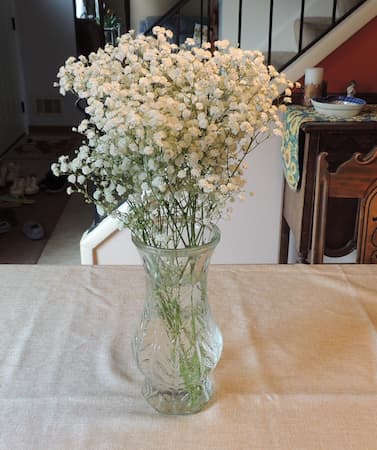How to Grow Baby's Breath Flowers (Gypsophila)

Growing Baby's Breath Flowers in Your Home Garden
Baby’s Breath flowers are tender and delicate annual flowers. Growing Baby’s Breath flowers is very easy. And they are quick to bloom. Also, they are commonly called “Gypsophila flowers” (their Latin botanical name). Gypsophila flowers are a popular flower to accent bouquets, corsages, and flower vases, Baby’s Breath is a popular flower in the home garden too. So, learn how to grow Gypsophila… read on.
Plants bear a profusion of white or pink flowers. The stems separate into many branches, giving it a light appearance, perfect for accenting. The plant has lance-shaped, linear to triangular leaves and wiry stems.
Baby’s Breath flowers are most often included in those dozen roses you give or receive. And they are a “must-have” for bridal bouquets.
Other Names: It is also called Chalk Plant
Baby's Breath / Gypsophila Plant Specifications
Flower Colors: White and pink, white. White is the most popular.
Flowers Bloom: Late Spring through Summer.
Days to Bloom: 8 weeks after seedling germination.
Plant height: 1 1/2 to 2 1/2 feet.
Light Requirements: Full sun
Ideal Soil pH: 6.0 – 7.5.
Hardiness Zones: 3 – 9
Native To: Africa, Asia, Australia, and Europe.
Toxicity: The plant is harmful to humans and pets.
Gypsophila elegans

Baby's Breath Plant Propagation
Baby’s Breath plants are grown from tiny seeds. They can be directly seeded into your flower garden in the spring or started indoors for a jump start on the year. The plants do not like frost. It will kill them or stunt their growth. For outdoor plant starts, sow Baby’s Breath seeds after the soil has begun to warm in the spring.
For an indoor plant start, sow seeds 6-8 weeks before the last frost in your area. Do not transplant indoor starts, until after the last frost date for your area.
Space plants eight inches apart.
Days to Germination: 10 – 15 days.

How to Grow Gypsophila Flower Plants
Baby’s Breath plants like full to partial sun.
They prefer rich, light soils, and are not fond of clay. Also, they do not like dry conditions. Their rapid growth demands that they be watered during dry periods. Keep the soil moist, not wet.
Add a general-purpose fertilizer before planting if the soil is poor.
Once your seedlings germinate, they will grow rapidly. For continuous bloom, plant them in succession every two to three weeks.
Baby’s Breath are great as dried flowers. To dry them, hang the plants upside down in an airy place, out of sunlight.
Insects and Plant Disease
Insect and disease problems are not too common. If insect or disease problems occur, treat early with organic or chemical insect repellents and fungicide.
Also see: Plant Problems – causes and cures.
Related Articles
People who read article also like:
How to Grow Gypsophila Flower – by Garden Hobbies
Please support our site. Shop for:
- rmmatthews100@hotmail.com
- 585-721-6528
- Rochester, NY
©1999-2024 GardenersNet.Com, All Rights Reserved

